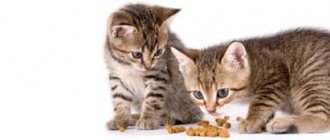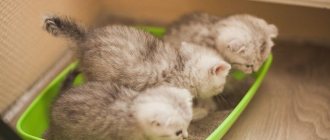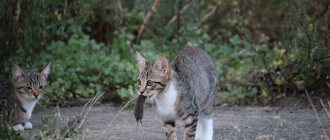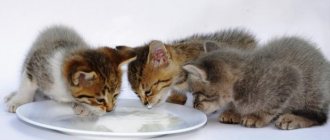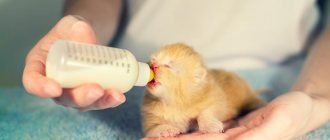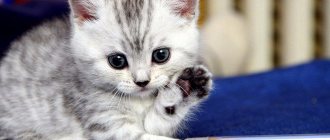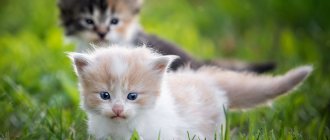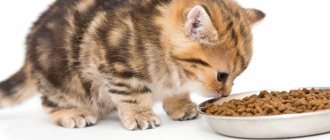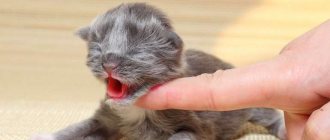What will you learn from the article?
- Kitten feeding regimen
- What foods can you feed a kitten?
- What to feed a one-month-old kitten (up to 1 month) What foods should you not feed a kitten
- Dry food for kittens
This article will help you learn how to feed your kitten correctly , calculate the diet, and avoid giving junk food.
Find out what food should be supplied to a small body in order for it to grow into a big, handsome cat.
What dangers await kittens at the bowl?
- unbalanced diet
Improper feeding affects the growth and development of the baby, leading to external defects and internal problems, and sometimes even death.
- poorly selected nutrition
The wrong choice of ready-made food, natural nutrition that causes allergic reactions - all this also negatively affects the growing body.
It is also important not to forget about a certain feeding schedule that is different from the schedule of an adult cat. Scary? Don't be shy, we'll figure it out!
Kitten feeding regimen
First, it is important to understand WHEN to introduce complementary foods and how often to feed the kitten. You, of course, can be guided by the kitten's hungry look, but it is better not to awaken the beast in him, and 3-4 weeks after birth, begin to gradually feed the baby.
By 4 weeks of age, a stable eating schedule should be established.
The baby should receive additional feeding 4-7 times a day.
But there are stalemate situations when kittens need additional feeding much more often.
How many times a day to feed:
- age up to 2 weeks – 10 times a day (with night coverage);
- feeding a one-month-old kitten – 8 times a day (including the night);
- 1 – 2 months – 7 times a day (night is already excluded);
- 2 – 3 months – 6 times a day;
- 4 months – 5 months – 5 times a day;
- 5 – 9 months – 4 times a day;
- 9 – 12 months – 3 times a day;
- Feeding kittens from 1 year of age becomes twice a day (for example, 9:00 – 21:00).
How much should a kitten receive per day?
- Age 1 week – 30 ml per 100 g of kitten weight;
- 2 weeks – 38 ml per 100 g of kitten’s weight;
- 3 weeks – 48 ml per 100 g of kitten’s weight;
- 4 weeks and subsequent – 48-53 ml per 100 grams of kitten weight.
Of course, it’s easy to calculate the amount of feed based on the items already proposed, but we’ll make the task easier and give a few numbers:
- At 1.5 months, a baby needs about 120 grams of food per day;
- We feed a two-month-old kitten more - 160-180 grams per day;
- During the period of active growth (3 months - 6 months), the daily food intake is 180-240 grams, with at least 40 grams of meat;
- A six-month-old baby needs up to 180 grams of food per day;
- At 10-12 months, the period when the kitten’s activity decreases, the daily food intake is 150-200 grams.
It is important to give vitamins to your pet. Read what vitamins to choose for a kitten.
How much protein does a cat need?
The biological need of an adult cat is about 5 - 6 g of animal protein per 1 kg of weight (maximum - up to 10 g with high activity). For example, a pet weighing 3 kg should receive at least 15 g of protein per day.
It is necessary to distinguish between the content of meat products and protein in feed. These are not equivalent concepts.
To clearly show the difference, let’s look at the composition of dry food Fitmin Cat For Life Hairball. The composition states that 87% animal proteins. This does not mean that after eating 100 g, a cat will receive 87 g of protein. For a correct calculation, we need a guaranteed analysis (manufacturers print it on the packaging along with the composition).
For a cat weighing 3 kg, the recommended daily dose is 50 g, of which she will receive (33/100) * 50 = 16.5 g of protein (5.5 g per kg of weight). The daily norm has been met. This, of course, does not guarantee that the manufacturer used high quality products. Unfortunately, legislation regulates only the percentage content of nutrients, and not the consumer properties of raw materials.
The situation is gradually improving: now many private and state examinations are being carried out, during which the actual composition is checked and compared with the guaranteed one. Manufacturers value their reputation, especially in the premium segment, so serious discrepancies with the numbers on the label are becoming less and less common.
What foods can you feed a kitten?
Remember that the food you put in your kitten's bowl should never be hot or cold. It is optimal if the food is at room temperature.
It is important to remember the consistency of food - it is better if the first portions are mushy and do not contain solid pieces. At home, a blender or an ordinary grater for milking vegetables will help with this.
So, what to feed a kitten:
- Meat. It can be raw, boiled, frozen and scalded. 60-80% of a kitten's daily diet comes from lean meat. What kind of meat is suitable for a kitten - see the table below;
- Liver. Offered once every 1-2 weeks;
- Porridge. In their pure form, the kitten is unlikely to be interested in them, but adding meat or vegetables radically changes the matter. Mix porridge with meat in a 1:2 ratio;
- Vegetables. Fresh or boiled;
- Eggs. What do kittens eat from eggs? Exclusively yolk. It is useful to give a raw yolk to a kitten once a week. Pay special attention to quail eggs - they are very healthy and quail eggs can be given whole, without separating the white from the yolk;
- Fermented milk products with low fat content;
- Brewer's yeast;
- Oil. Experts recommend avoiding vegetable oil and replacing it with Vaseline.
Expensive vs. cheap
– There are several classes of feed. “Superpremium”, “premium”, “economy”, as well as “holistic” (Human Grade) - the quality is as if the product was made for people. In the production of such feeds, technologies are used that make it possible to preserve all the benefits of the ingredients, their digestibility is at least 80%, no by-products, only clean meat. As for the rest, the degree of presence and digestibility of useful components depends on the class,” says Galina Chernova.
And Darina Berezina recommends not to get carried away with cheap food and draws an analogy between them and instant soups like Doshirak. If you eat exactly this all the time, then gastritis will not keep you waiting. Whatever one may say, in the end the cat chooses the food itself. All you have to do is first give her a choice, and then regularly fulfill her preferences.
“If a cat likes the food, she feels good after it, she has no problems with digestion or urination, she is active and has good hair, then it suits her,” says Ekaterina Nigova. – Perhaps some cat will like food that is more expensive, and some will choose cheaper food, there is nothing wrong with that.
The doctor also explains that the classification of feed is rather arbitrary. Of course, the manufacturer understands approximately what quality customers expect from food of a certain class, and tries to meet the declared level, but in fact there are no prescribed parameters that classify food into one group or another. In Europe and America (where feed most often comes from on the Russian market), there are still organizations that certify feed and are responsible for its safety. However, even if you have “holistic” food in front of you, you cannot say for sure that it is made from the best and freshest meat, and not yesterday’s meat. Regarding controversial additives, we note that regulations determining which additives are safe and allowed for use and which are not still exist and the manufacturer is obliged to follow them.
What to feed a one-month-old kitten (up to 1 month)
A well-fed kitten either sleeps peacefully or quietly sucks the cat. But if kittens crawl around their mother, refuse the nipple, squeak and grab an outstretched finger - these are signs that the child is hungry.
Where to start with complementary feeding or full feeding of a week-old pet?
Prepare a bottle with a nipple, a dropper or syringe without a needle, and a special mixture designed to replace cat milk for a week-old kitten.
Here are some simple recipes on how to feed small kittens at home:
- Raw egg yolk + half a liter of concentrated milk
- Dry yeast (2.5 g) + whole milk powder (15 g) + whole cow's milk (50 g)
- Hard-boiled egg + beaten egg white + vegetable oil (1 g) + grape sugar (4 g)
- Half an egg yolk + corn oil (teaspoon) + whole milk (50 ml)
These and other recipes will also be useful if the kitten grows up without a mother cat and (correctly), its feeding is entirely your responsibility.
Read about recipes for feeding kittens up to a month without a cat
What foods should you not feed your kitten?
- Dry or wet food. There is no unanimity on this issue; rely on your own prudence and intuition. Therefore, here we put a question mark – ?
- Cow's milk. It is better to replace it with goat milk - it is not so fatty for the baby’s digestion. If you can’t get goat milk, then for very small kittens you can buy special powdered milk in pet stores
- Fermented milk products with high fat content
- Fish. In principle, children should not be given fish at all, but theoretically, sea fish is not harmful. Freshwater is prohibited, especially raw water, as it provokes the formation of urolithiasis and can become a source of infection with worms
- Salt, spices
- Sausages
- Potatoes are not at all digestible by the stomach of a domestic cat, so they are not given in any form.
- Legumes. Soy, peas, beans are not digested by the intestines and as a result we get bloating and fermentation in the intestines
- Cheese - due to its fat content
- Pork
- Sweets
- Chocolate. This particular sweet contains theobromine, a poison that causes severe poisoning and death in cats.
- Flour
- Mixed diet is harmful for kittens
Read more about what not to feed.
Why is a low-protein diet indicated for chronic renal failure?
Many representatives of artificially bred breeds have kidney problems. The most common among them is kidney failure. In addition to congenital pathology, its cause may be other diseases, deficiency of beneficial microelements, poisoning, and hypothermia.
A cat that has been diagnosed with this disease needs treatment and special nutrition. Her metabolism is disrupted, the body cannot (fully or partially, depending on the stage) remove metabolic products. As a result, a large number of toxins enter the blood. In the absence of timely, competent therapy, the animal dies. Fortunately, effective treatment methods have already been developed and there are drugs. If the disease is “caught” at an early stage, then a caring owner can provide his furry friend with a long, fulfilling life.
Nutrition in the treatment of chronic renal failure is of considerable importance. It can either help achieve significant improvement or make the situation worse. Typically, veterinarians will prescribe a lifelong low-protein diet.
Reducing protein in the diet inhibits hyperfiltration, which leads to degradation of kidney tissue and reduces general intoxication due to excess urea.
Can I give it to a kitten - food table
| Product | Can I give it to a kitten? |
| Banana | No |
| Borsch | No |
| Broccoli | Yes |
| Buckwheat | Yes |
| Baby food | Yes |
| Potato | No |
| Kefir | Yes |
| Food for adult cats | No |
| Semolina | No |
| Milk | No |
| Carrot | Yes |
| Oatmeal | Yes |
| Cucumber | Yes |
| Liver | Yes |
| Tomato | Yes |
| Rice | Yes |
| Fish | No |
| Ryazhenka | Yes |
| Sour cream | No |
| Soup | Yes |
| Raw meat | Yes |
| Cottage cheese | Yes |
| Grass | No |
| ground meat | Yes |
| Bread | No |
| Chocolate | No |
| Apple | Yes |
| Egg | Yes |
Features of the diet by month
Features of feeding a kitten aged 2 – 4 months
By this age, the kitten has already cut its teeth and it is time to transfer it to autonomous feeding, teaching it to eat and drink from bowls on its own. The kitten's growth is very active, its skeleton is being formed and strengthened, and the gastrointestinal tract is finally formed. What to feed a 2 month old kitten? The baby's diet should be as fortified as possible and especially rich in protein.
Features of feeding a kitten aged 4 – 6 months
At this age, the baby is actively gaining weight, so you need to make sure that the basis of the diet is not foods that are stored as fat, but those that increase muscle mass.
The baby's jaw has already formed and pieces of meat, beef or chicken offal can be given not ground, but cut into pieces. What else do kittens eat at this age? It is recommended to gradually add fermented baked milk or yogurt to low-fat fermented milk products.
Features of feeding a kitten aged 6 – 10 months
During this period, the daily number of feedings is actively reduced. The kitten's growth becomes less noticeable, but its taste preferences are already emerging. Do not indulge the cat's whims and do not give your teenager prohibited foods or food from the table. At this age, you can treat your pet with low-fat sea fish from time to time.
Read what should be in your veterinary medicine cabinet at home.
Consequences of poor nutrition
Proper nutrition for kittens = future health of the cat.
It is not for nothing that at the beginning of the article we focused on how important it is for the kitten to receive a balanced diet.
An imbalance of nutrients (microelements, vitamins, etc.) leads to serious problems with the health of the animal:
- Diabetes
Kittens sometimes have so-called juvenile diabetes. There are individuals who are genetically predisposed to it, so don’t be reckless and don’t provoke the manifestation of the disease with improper nutrition
- Feline vitamin deficiency
– lack of vitamin E (tocopherol) leads to a deterioration in the quality of the coat, irreversible changes in muscles and the development of infertility in the future.
– lack of vitamin C undermines the immune system and can lead to scurvy;
– vitamin D is responsible for calcium-phosphorus metabolism and prevents the development of rickets;
– vitamin A deficiency leads to digestive disorders and development of reproductive organs.
- Allergy
- Poisoning
As we wrote above, there are foods that are literally poison for cats (chocolate, onions, garlic). And it’s good if loose stools are the only and quickly relieved symptom of poisoning. Often, consuming these products can be fatal for your pet.
Of course, this is not the entire list of problems threatening the baby, but we have highlighted the main points.
Is it possible to give raw eggs?
Eggs are good for pets. They contain:
- protein;
- amino acids;
- vitamins A, D, E, B;
- omega-3;
- antioxidants;
- calcium;
- selenium;
- zinc.
There is no Salmonella in eggs, but the bacteria can be found in chicken droppings. If he stains the shell and it cracks, salmonella can get inside.
To avoid problems, do not buy products with cracked shells. Before giving your pet raw eggs, be sure to wash them in hot water.
Features of dog nutrition
Feed your dog after an active walk, otherwise stomach volvulus may occur. Even if this does not happen, the pet will be passive, since a full stomach will not allow it to run and jump normally.
Dogs are omnivores with a predatory bent. They have sharp teeth and a short gastrointestinal tract, which is better suited for digesting meat than plant foods. However, dogs produce enzymes that are responsible for the absorption of glucose and starch, and are able to break down carbohydrates - this is what true carnivores lack.
Ready-made food for kittens
What is better to feed kittens - dry food or natural food? The question is complex. To feed a kitten with ready-made food or not to feed it – Shakespearean passions have been in full swing for many years. If we assume that good and responsible producers have put all the necessary microelements, minerals, vitamins and additives in a jar or bag of food, then feeding with ready-made food has its place, moreover, it makes life easier for the kitten owner. And reviews from veterinarians about such feeding at home are positive.
The best ready-made food is Akana Regionals (composition details on the official website)
But if you choose this light option, you simply must learn a few important rules:
- The main rule is called “Either-or”. Either ready-made food or natural feeding. You can't mix. Not at all. Not even a drop! Natural food and prepared food are digested differently. The first is absorbed without drinking a lot, and the digestion of dry food requires a lot of moisture, without which enzymolysis does not begin. If you change the types of food, then the kitten’s stomach and intestines will not have time to rebuild and as a result - hello, gastroenteritis, coprostasis (intestinal obstruction) and other troubles
- Is it possible to give a kitten only one food? Need to! Having chosen ready-made food for a kitten, do not change it (food) for another. Each brand has its own blend and balanced composition. By making a cocktail out of food, we risk introducing an imbalance and as a result we will get a strange picture in the kitten regarding calcium, say, or amino acids
- Do not buy mass-market food for your kitten - only specialized food for kittens and only the highest class (holistic, super-premium, premium food). What is below is not food, but fast food, these bright and cheap jars will bring nothing but problems
Dry food for kittens Club 4 Paws “Chicken”
Balanced premium food with high nutritional value (34% protein, 15% fat) is produced in Ukraine. The main ingredients are chicken (26%) and cereals (rice, corn), the food also contains poultry and salmon fat, animal protein, dried vegetables and fruits, brewer's yeast, flaxseed, beet fiber
Benefits of the food:
- meat ingredients are in 1st place in the composition;
- INTEGRAMIX formula for comprehensive health support;
- a mixture of tocopherols as a natural antioxidant and source of vitamin E;
- optimal price-composition ratio.
The disadvantages include the presence of only one taste.
Buy food on Petslike.
Wet food for kittens Club 4 Paws
The K4L line of wet food for kittens is represented by two diets with an attractive taste:
- with chicken in sauce;
- with turkey in jelly.
Advantages of feed:
- high meat content in pieces;
- good vitamin and mineral supplement;
- contain the INTEGRAMIX complex to maintain overall health and immunity;
- no synthetic additives.
Flaws:
- Turkey food contains a small amount of sugars.
Best price on Petslike.
Kitten food Optimeal "Chicken"
Super-premium dry food, produced in Ukraine using Swiss technology. The nutritional value (40% protein, of which 60% is animal origin, 18% fat) meets the needs of kittens.
Advantages of Optimeal kitten food:
- balanced composition;
- chicken meat is added fresh;
- a complex of supplements to support immunity Immunity Support Mix;
- good value for money.
Flaws:
- presence of only one taste;
Buy food from the Pethouse online pet store.
Wet food for kittens Optimeal with chicken
Super premium food contains fresh chicken, beef heart, and chicken liver.
Pros:
- 80% meat in pieces;
- high content of animal proteins – 71%;
- the presence of additives for immunity, skin and coat;
- no artificial additives.
Disadvantages include the lack of information about the origin of cereals, which are included in small quantities in the composition.
Best price here.
What else should you pay attention to?
Diets for kittens from Hill's Science Plan Puppy & Kitten, Royal Canin Size Nutrition Mini Junior and many others are deservedly popular.
But if the picture is clear with elite food, then super-premium or premium food requires a more thorough analysis. Let's look at a few examples.
Which food to choose for a kitten - rating
Dry food for kittens
Almo Nature dry food for kittens
This dry food is very close to VIP food. This Italian diet is based on chicken and its derivatives. Animal protein accounts for 53%, another 14% is non-allergenic rice.
There are not many disadvantages to this food - perhaps only the high price.
Best price in the Staraya Ferma online store.
Acana super premium kitten food
Today Akana offers dishes in three flavors:
- chicken;
- fish;
- lamb.
Benefits of Akana kitten food:
- Balanced diet
- No grains included
- No dyes or artificial additives
Disadvantages of Akana kitten food:
- Narrow range of flavors
- Lack of preventive diets
Buy food on Zoopassage.
Royal Canin dry food for kittens
Premium class in kitten nutrition is the best of the worst, and it is important to remember that the absence of the prefix “super” indicates that the quality of food of this type is, to put it mildly, “not very good.” But let's be objective.
Advantages of Royal Canin kitten food:
- Low price;
- Veterinary line;
- Wide range of flavors;
- Availability for sale.
Buy at the best price in the Staraya Ferma online store.
Disadvantages of Royal Canin kitten food:
- Low quality;
- Questionable composition;
- The manufacturer, Mars, specializes in economy-class feed. It's a hint.
Cat or cat: how to determine gender
Video about proper feeding at home
Wet food and canned food
It is believed that wet food, consisting of 80% water, is more suitable for babies, since it is completely absorbed in the stomach and does not injure the esophagus.
Remember that canned food and pouches should be kept in the refrigerator, but be sure to reheat before serving. Uneaten wet food should be put back in the refrigerator until the next feeding.
What wet foods are in demand among cat owners?
Bosch Sanabelle wet food
This super-premium food is produced in Germany. It is distinguished by a very well-balanced composition - 35% protein (and almost all of animal origin), 7% mineral additives.
The advantages of Bosch Sanabel include:
- Decent quality;
- No artificial ingredients;
- Availability in stores.
Disadvantages:
- Contains allergy-causing cellulose and maize.
Buy this food on the Staraya Ferma website.
ProPlan Junior
Proplan is a premium food for kittens that can be purchased at any pet store.
Its advantages:
- Wide range of flavors;
- Natural meat included;
- Prebiotics included;
- Balanced diet for kittens.
Its disadvantages:
- Large percentage of plant proteins;
- Presence of allergenic corn and soy;
- Contains preservatives.
The most attractive prices for this food are on the Staraya Ferma website.
Hills food for kittens
Hills is another premium brand.
The advantages of this food include:
- Availability
- Rich in vitamins and minerals
The disadvantages are:
- A large percentage of carbohydrates in the composition that are poorly digested by kittens;
- Too much vegetable protein;
- Allergenicity of food;
- There is a lot of broth in canned food and packages.
You can buy it at the best price here.
How much should you limit protein and phosphorus?
There is still no clear conclusion on the optimal amount of animal protein consumed for kidney disease. The situation is complicated by the lack of large-scale studies that would give reliable results. Experts are discussing this issue, but general recommendations have been established: therapeutic diets have been developed for different stages of CKD. Their protein content is reduced to 58 - 82 g of protein per 1000 kcal for cats. When making calculations, the doctor must take into account the patient’s condition and make adjustments based on diet tolerance.
The phosphorus content in therapeutic diets should not exceed 1.35 g per 1000 kcal. In this case, it is necessary to monitor blood plasma parameters. If, through dietary restriction, it is not possible to achieve normal concentrations, hyperphosphatemia persists (0.9-1.5 mmol/l in the second stage of CKD and 1.6-1.9 mmol/l in the third), it is necessary to add drugs that bind phosphorus in the intestines.
All medications must be prescribed by a doctor based on test results.
If the animal is undergoing treatment, then it is necessary to monitor the response to complex therapy. This will allow you to correctly assess his condition and, if necessary, optimize the nutrition process and the doses of medications taken. When improvements occur, the diet cannot be stopped. If chronic renal failure is already an established fact, then your doctor will recommend that you completely switch your pet to premium low-protein cat food.
